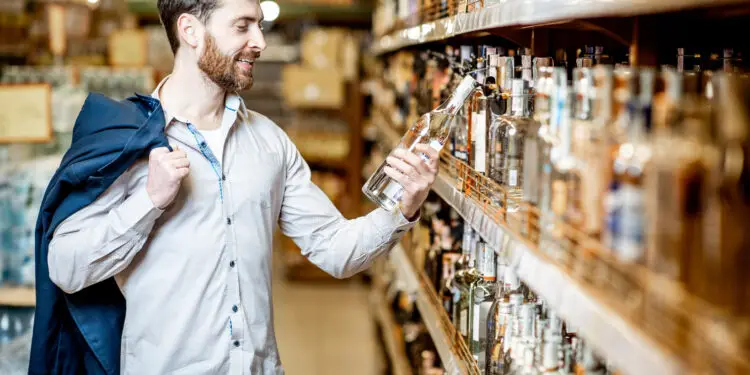Table of Contents
Navigating the World of Liquor Distribution Requires a Multifaceted Approach
The lifeblood of a distiller are retail liquor distribution channels. A distiller must gain access to liquor store sales as well as bars and restaurants. In the Distiller’s Guide to Liquor Distribution, you will quickly learn that it’s not just about having a great product. If you are fortunate-enough to gain access to a quality liquor distributor, your product needs to perform quickly or it will likely get tossed aside in favor of brands that have a faster sales velocity. It’s a tough business and not many distillers are prepared for the challenge. We hope this Distiller’s Guide to Liquor Distribution will help you manage expectations and prepare to compete in this dynamic and competitive marketplace.
The strategic dilemma of prioritizing velocity (“velocity” is defined as the rate of turnover of product sales) versus expanding distribution networks to widen market reach, stands central to a distiller’s business evolution. This choice is more than a mere operational decision; it can significantly influence the brand’s longevity, profitability and survival.

Source: Statista
For these emerging players in the spirits sector, understanding the intricate dynamics between sales velocity and distribution breadth is essential. Velocity reflects the brand’s resonance with its target audience and the effectiveness of its marketing and sales strategies. Increasing velocity not only boosts immediate revenue but also strengthens the brand’s market position, encouraging retailer confidence and customer loyalty.
Conversely, distribution expansion, the process of broadening the availability of products across new markets and channels, necessitates a nuanced approach to scaling operations and managing supply chains. This strategy extends the brand’s reach, diversifies its consumer base, and enhances its resilience against market fluctuations.
In this article, we discuss the strategic considerations that small distilleries must navigate to optimize their growth. We will examine how balancing the focus on sales velocity and distribution expansion can lead to sustainable business success. By dissecting the methodologies for measuring and enhancing these key performance indicators, we provide actionable insights for distillery owners and business professionals in the spirits industry. As we explore the complexities of these strategic choices, our goal is to offer a comprehensive guide that not only addresses immediate business needs but also sets the foundation for long-term brand development and success in the ever-evolving spirits market.

Understanding Velocity and Distribution in The Liquor Industry
Velocity refers to the rate at which products are sold and replenished in retail outlets. High velocity indicates strong consumer demand and efficient inventory turnover. Distribution, on the other hand, pertains to the extent of a product’s availability across different markets and retail channels. It’s about the breadth and depth of market penetration.
Measuring Velocity and Distribution In the Liquor Industry
Velocity is measured by sales volume over a specific period, often tracked through point-of-sale (POS) data, indicating how quickly products are moving off the shelves. Distribution is gauged by the number of outlets selling the product, encompassing both geographical spread and market segmentation.
Strategies for Increasing Velocity In the Liquor Industry
Increasing the velocity of product sales in the spirits industry hinges on a multi-faceted approach that combines product excellence, strategic marketing, pricing, and retailer relationships. Here’s how these strategies interplay to boost sales momentum:
Product Excellence and Branding: The cornerstone of sales velocity is the quality and branding of your product. Superior product quality ensures customer satisfaction, fosters loyalty, and establishes a reputable brand image. A strong brand resonates with consumers, creating an emotional connection that transcends the initial purchase and fosters ongoing consumer engagement.
Targeted Marketing: Velocity gains momentum with targeted marketing efforts that increase product visibility and appeal to the right audience. By crafting marketing campaigns that resonate with the specific preferences and needs of your target demographic, you can drive demand and encourage repeat purchases. This involves leveraging data analytics to understand customer behavior, preferences, and trends, enabling personalized and effective marketing strategies that capture attention and stimulate sales.
Pricing Strategy: The pricing of your products plays a crucial role in influencing purchasing decisions and, consequently, sales velocity. Competitive pricing, coupled with timely promotions, can create a sense of value and urgency, encouraging consumers to make a purchase. However, it’s vital to balance these tactics with the overall brand positioning to ensure that price promotions do not dilute the perceived value of the brand. Thoughtful pricing strategies that reflect the product’s quality and brand prestige can optimize sales while maintaining brand integrity.
Retailer Relationships: Finally, nurturing strong relationships with retailers can significantly enhance product visibility and availability, directly impacting sales velocity. Collaborative partnerships with retailers can lead to favorable shelf positioning, enhanced in-store promotion, and better inventory management. By offering incentives and support to retail partners, distilleries can ensure their products are prominently displayed and actively promoted, leading to increased consumer exposure and sales.

Together, these strategies form a comprehensive approach to increasing sales velocity in the spirits industry, each contributing to building a strong market presence and driving consumer demand.
Strategies for Increasing Distribution
Expanding distribution in the spirits industry requires a strategic approach grounded in thorough market research, effective channel partnerships, robust supply chain management, and meticulous regulatory compliance. Here’s how these strategies work together to widen market reach and enhance distribution networks:
Market Research: The foundation of effective distribution expansion is a deep understanding of market dynamics. Conducting comprehensive market research helps distilleries identify where their product fits within the broader market landscape and pinpoint untapped or underserved regions. This knowledge enables distilleries to make informed decisions about where to focus their distribution efforts, ensuring they target areas with the highest potential for market penetration and revenue growth.
Channel Partnerships: Building strong relationships with distributors, brokers, and retailers is vital to extending a product’s reach. Effective channel partnerships allow distilleries to tap into established networks, gaining access to new geographical markets and retail formats. By collaborating with experienced partners, distilleries can leverage their expertise and infrastructure to facilitate market entry and expansion, thereby increasing the availability of their products to a wider audience.
Supply Chain Management: As distribution networks grow, the complexity of managing production and logistics also increases. Effective supply chain management ensures that distilleries can scale up their operations to meet the demands of expanded distribution channels. This includes optimizing production processes, inventory management, and logistics to ensure timely and efficient delivery of products to new and existing markets, minimizing potential supply chain disruptions.
Regulatory Compliance: Expanding your liquor distribution, especially into new markets, requires a thorough understanding of the regulatory environment. Distilleries must navigate the complex web of local, national, and international regulations governing the sale of alcoholic beverages. Ensuring compliance with these regulations is crucial for smooth market entry and sustainable distribution operations, preventing legal issues and maintaining the brand’s reputation.
Increasing distribution in the spirits industry demands a comprehensive and well-coordinated strategy. These elements work synergistically to enable distilleries to efficiently expand their market reach and secure a competitive edge in the global spirits market.
Balancing Velocity and Distribution
For small, fast-growing distilleries, balancing the focus between increasing velocity and liquor distribution is key. Initially, a strong emphasis on velocity can build a robust brand reputation and consumer demand, creating a solid foundation for broader distribution. Once a certain level of market penetration and brand recognition is achieved, expanding distribution can amplify growth.
However, expanding distribution too quickly without adequate demand (velocity) can lead to overextension and inventory issues. Conversely, focusing solely on velocity without plans for distribution growth can limit overall market potential.
Practical Steps for New Brands
- Start Locally: Begin with a strong local presence to build brand loyalty and understand your market before expanding.
- Leverage Data: Utilize sales and market data to make informed decisions about where and how to expand distribution or focus on velocity.
- Build Relationships: Network with industry stakeholders, including distributors, retailers, and consumers, to enhance brand visibility and market access.
- Invest in Marketing: Develop a marketing strategy that aligns with your brand identity and appeals to your target audience.
- Monitor and Adapt: Continuously evaluate market performance and be prepared to adjust strategies to optimize velocity and distribution.
Distillery owners can significantly enhance their market presence and distribution in the spirits industry by adopting targeted strategies. Below, I’ve outlined these strategies, accompanied by actionable steps to facilitate their implementation effectively.
Some actionable strategies for increasing distribution in the spirits industry are as follows:
- Diversify Retail Channels: Extend your product’s availability beyond traditional liquor stores to include supermarkets, convenience stores, online retailers, and hospitality venues like bars and restaurants. Action: Negotiate partnerships and contracts with a variety of retail channels to ensure a broader market presence.
- Leverage Trade Shows and Industry Events: Participate in trade shows, tasting events, and industry expos to showcase your products to potential distributors, retailers, and consumers. Action: Book exhibition space at relevant events, prepare product samples and promotional materials, and network actively during these events.
- Utilize Digital Marketing and E-commerce: Enhance your online presence through targeted digital marketing campaigns and by selling your products on e-commerce platforms. Action: Develop a strong digital marketing strategy, including SEO, social media, and online advertising, and set up an online shop or partner with existing e-commerce platforms.
- Implement a Field Sales Team: Deploy a dedicated sales team to directly engage with potential new accounts and manage existing ones. Action: Hire and train sales representatives with industry knowledge and territory management skills to actively pursue new distribution opportunities.
- Offer Promotions and Incentives: Attract new distributors and retailers with promotional pricing, volume discounts, or marketing support. Action: Develop a promotional plan that includes discounts, limited-time offers, and co-marketing opportunities to encourage new accounts to stock your products.
- Develop Limited Editions or Exclusive Products: Create special product lines or limited-edition releases exclusive to certain retailers or markets. Action: Research market trends and customer preferences to develop unique products that appeal to specific segments or partners.
- Focus on Education and Brand Storytelling: Educate your distributors, retailers, and consumers about the uniqueness of your products and the story behind your brand. Action: Develop educational materials, conduct training sessions, and use storytelling in your marketing to deepen market engagement and brand loyalty.
In parallel with expanding distribution, brands must take action to increase velocity. Brand owners should focus on the following actionable strategies.
- Optimize Pricing Strategy: Conduct market research to find the optimal price point that attracts consumers without sacrificing profit margins. Action: Analyze competitor pricing, understand consumer price sensitivity, and adjust your pricing to maximize sales volume.
- Enhance In-store Visibility: Secure prime shelf placement and invest in eye-catching in-store displays. Action: Negotiate with retailers for better shelf space and create attractive point-of-sale displays that draw attention to your products.
- Leverage Social Media Marketing: Utilize social media platforms to create buzz around your products and encourage consumer engagement. Action: Develop a content calendar, post regularly about your products, and interact with your audience to build brand loyalty and encourage purchases.
- Engage with Local Communities: Participate in local events, sponsor community activities, or host tastings to build brand awareness and loyalty in your local market. Action: Identify and participate in community events, sponsor local activities, and host product tastings to engage directly with potential customers.
- Collaborate with Influencers and Brand Ambassadors: Partner with influencers and brand ambassadors who can authentically promote your products to their followers. Action: Identify influencers in the spirits or related lifestyle sectors and collaborate on promotional campaigns to reach a wider audience.
- Focus on Product Quality and Innovation: Continuously improve and innovate your product offerings to meet consumer trends and preferences. Action: Invest in product development and quality control to ensure your products meet high standards and align with current market trends.
- Build Strategic Partnerships: Partner with complementary brands, businesses, or events to cross-promote your products and access new customer segments. Action: Identify potential partnership opportunities with businesses that share your target market and collaborate on joint marketing initiatives or events.
While the decision between focusing on velocity or distribution presents a dichotomy, the most successful distilleries often find a dynamic balance between the two. It’s about growing demand while simultaneously expanding the ability to meet that demand across broader markets. New brands should aim for a phased approach, starting with establishing a strong product and brand presence (velocity), followed by strategic distribution expansion to capitalize on established market demand. This balanced growth strategy can lead to sustained success in the competitive wine and spirits industry.
For more insights and updates on the spirits industry, I invite you to connect with me on LinkedIn. Follow my profile to stay informed about the latest trends, discussions, and opportunities.
A native of Long Island, New York, Eric's educational journey led him to Boston College, where he graduated with concentrations in Accounting and Finance. Currently residing in Colorado, Eric embraces the outdoor lifestyle, finding balance and inspiration in hiking, running marathons, and competing in triathlons. This love for adventure and challenge mirrors his professional approach, where innovation, endurance, and strategic foresight are key.
Eric's transition to the distillery industry was driven by a desire to apply his financial expertise to a field he is passionate about, underscoring the importance of sustainability, innovation, and craftsmanship in distilling. His contributions have not only enhanced the financial health of the organizations he's been a part of but also fostered growth and excellence within the industry at large.
For those looking to connect with Eric or learn more about his professional journey and insights into the distillery industry, he is available on LinkedIn. His profile offers a window into the blend of professional excellence and personal zeal that defines his career and contributions to the distillery sector.
- How Alcohol Brands Can Maximize Year-End Sales and Prepare for Q1 - December 11, 2024
- On-Premise Liquor and Wine Sales: Winning Strategies - November 16, 2024
- Holiday Rush Ready: Preparing Your Liquor Store for Year-End - September 26, 2024










